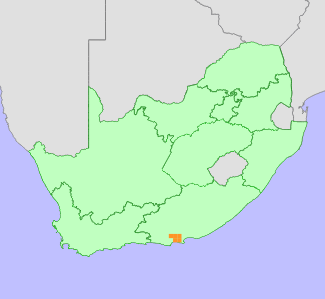|
Scientific Name | Leucadendron orientale I.Williams |
Higher Classification | Dicotyledons |
Family | PROTEACEAE |
Common Names | Van Staden's Sunbush (e) |
National Status |
Status and Criteria | Vulnerable B1ab(iii)+2ab(iii); C2a(ii) |
Assessment Date | 2020/04/16 |
Assessor(s) | A.G. Rebelo, D. Raimondo & L. von Staden |
Justification | Leucadendron orientale is a restricted endemic with an extent of occurrence (EOO) of 834 km² and an area of occupancy (AOO) of 60 km² and is known from between seven and 10 locations. Afforestation has led to 17% of this species' habitat being irreversibly transformed. While new areas are no longer planted up, there is still ongoing degradation of this species' habitat as a result of invasive alien plants. Ten subpopulations of this species have been recorded and all of which have fewer than 1000 individuals and the total known population does not exceed 10 000 individuals. This species therefore qualifies for listing as Vulnerable under criteria B and C. |
Distribution |
Endemism | South African endemic |
Provincial distribution | Eastern Cape |
Range | This species is endemic to the eastern parts of the Fynbos Biome, occurring from Cockscomb to Van Stadens Mountains in the Eastern Cape, South Africa. |
Habitat and Ecology |
Major system | Terrestrial |
Major habitats | Kouga Grassy Sandstone Fynbos, Kouga Sandstone Fynbos |
Description | It is restricted to growing in sandstone soils, from 150 to 850 m.a.s.l. Mature individuals are killed by fires, and only seeds survive. Seeds are released after ripening, and collected by rodents and stored in underground caches, where they are protected from fires. It is dioecious, with insect-pollinated male and female flowers occurring on separate plants. |
Threats |
| A total of 17% of this species' habitat has been irreversibly modified to afforestation in the past. No new areas have been planted up in the past decade however a number of subpopulations are threatened by invasive alien species including Pinus, Hakea and Acacia. One subpopulation consisting of a couple of hundred plants was ploughed in 1997 for planting of Protea orchards. As a number of subpopulations are naturally small this may indicate that this species is not able recruit easily and fire may play a role in recruitment failure. |
Population |
This species occurs as widely scattered stands along two mountain chains, the Groot Winterhoek Mountains and the Elandsberg Mountains. The overall population is suspected to be less than 10 000 mature individuals and fewer than 1000 individuals occur in all recorded subpopulations.
Six isolated subpopulations occur along the Grootwinterhoek Mountains most have between 100 and 1000 plants, with the subpopulation on the Cockscomb consisting of fewer than 100 individuals.
On the Elandsberg range two subpopulations have gone extinct; one was lost to afforestation at the Loerie Plantation between 1950 and 1980 and a second at Longmore forestry office was lost to the planting of a protea orchard in 1997. A sizable subpopulation of a couple of hundred plants occur at Montview on the Van Stadensberg, while a second subpopulation of around 100 plants occurs along the slopes below Platberg also on the Van Stadensberg mountain. Two other subpopulations of small isolated stands with a handful of plants were recorded in the Longmore forest region by the Protea Atlas project in 2000, it is not known if they are still extant. The population at the Van Staden’s Nature Reserve is cultivated.
|
Population trend | Decreasing |
Conservation |
| It is present in Baviaanskloof and Longmore “Mountview” Nature Reserves, and Witteklip Private Nature Reserve. |
Assessment History |
Taxon assessed |
Status and Criteria |
Citation/Red List version | | Leucadendron orientale I.Williams | EN B1ab(i,ii,iii,iv,v)c(iv)+2ab(i,ii,iii,iv,v)c(iv) | Raimondo et al. (2009) | | Leucadendron orientale I.Williams | Vulnerable | Hilton-Taylor (1996) | | Leucadendron orientale I.Williams | Indeterminate | Hall et al. (1980) | |
Bibliography |
Goldblatt, P. and Manning, J.C. 2000. Cape Plants: A conspectus of the Cape Flora of South Africa. Strelitzia 9. National Botanical Institute, Cape Town.
Hall, A.V., De Winter, M., De Winter, B. and Van Oosterhout, S.A.M. 1980. Threatened plants of southern Africa. South African National Scienctific Programmes Report 45. CSIR, Pretoria.
Hilton-Taylor, C. 1996. Red data list of southern African plants. Strelitzia 4. South African National Botanical Institute, Pretoria.
Manning, J.C. and Goldblatt, P. 2012. Plants of the Greater Cape Floristic Region 1: The Core Cape Flora. Strelitzia 29. South African National Biodiversity Institute, Pretoria.
Raimondo, D., von Staden, L., Foden, W., Victor, J.E., Helme, N.A., Turner, R.C., Kamundi, D.A. and Manyama, P.A. 2009. Red List of South African Plants. Strelitzia 25. South African National Biodiversity Institute, Pretoria.
Rebelo, T. 2001. Sasol Proteas: A field guide to the proteas of southern Africa. (2nd ed.). Fernwood Press, Vlaeberg, Cape Town.
|
Citation |
| Rebelo, A.G., Raimondo, D. & von Staden, L. 2020. Leucadendron orientale I.Williams. National Assessment: Red List of South African Plants version 2024.1. Accessed on 2025/10/17 |
 Comment on this assessment
Comment on this assessment

